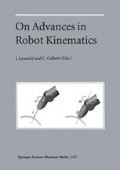Abstract
The workspace of wire robots is limited due to three factors: minimal and maximal lengths of the wires, static equilibrium that imposes to have a positive only force in the wires and wires interference (either intersection between 2 wires or between a wire and the end-effector). The limitation by the two first factors may be reduced by having wires with a large coiling ability and by increasing the number of wires. We propose in this paper algorithms that allow to study the influence of wire/wire and wire/end-effector interference on the workspace, assuming a fixed orientation of the end-effector. These algorithms allow one to determine exactly which region of the workspace is interference free.
Access this chapter
Tax calculation will be finalised at checkout
Purchases are for personal use only
Preview
Unable to display preview. Download preview PDF.
References
Albus J., Bostelman R., and Dagalakis N. The NIST ROBOCRANE. J. of Robotic Systems, 10 (5): 709–724, July 1993.
Arai T. and others. A hybrid drive parallel robot for heavy material handling. IEEE Robotics and Automation Magazine, 9 (l): 45–54, March 2002.
Baumann R., Maeder W., Glauser D., and Clavel R. The Pantoscope: a spherical remote-center-of-motion parallel manipulators for force reflection. In IEEE Int. Conf. on Robotics and Automation, pages 718–723, Albuquerque, April, 21–28, 1997.
Bostelman R., Albus J., Dagalakis N., and Jacoff A. RoboCrane project: an advanced concept for large scale manufacturing. In Proceedings Association for Unmanned vehicle systems International, pages 509–521, Orlando, July, 15–19, 1996.
Geng Z. and Haynes L.S. A 3–2–1 kinematic configuration of a Stewart platform and its application to six degree of freedom pose measurements. Robotics & Computer– Integrated Manufacturing, ll(l):23–34, March 1994.
Gosselin C. Determination of the workspace of 6-dof parallel manipulators. ASME J. of Mechanical Design, 112 (3): 331–336, September 1990.
Higuchi T., Ming A., and Jiang-Yu J. Application of multi-dimensional wire crane in construction. In 5th Int. Symp. on Robotics in Construction, pages 661–668, Tokyo, June, 6–8, 1988.
Homma K. and Arai T. Upper limb motion assist system with parallel mechanisms. In 2nd Japan-France Congress on Mechatronics, pages 388–391, Takamatsu, November, 1–3, 1994.
Jeong J.W., Kim S.H., and Kwak Y.K. Kinematics and workspace analysis of a parallel wire mechanism for measuring a robot pose. Mechanism and Machine Theory, 34 (6): 825–841, August 1999.
Kawamura S. and others. High-speed manipulation by using parallel wire-driven robots. Robotica, 18 (1): 13–21, 2000.
Maier T. and Woernle C. Inverse kinematics for an underconstrained cable suspension manipulator. In ARK, pages 97–104, Strobl, June 29- July 4, 1998.
Merlet J-P. Determination of the optimal geometry of modular parallel robots. In IEEE Int. Conf. on Robotics and Automation, Taipei, September, 14–19, 2003.
Merlet J-P. Determination of 6d workspaces of Gough-type parallel manipulator and comparison between different geometries. Int. J. of Robotics Research, 18 (9): 902–916, October 1999.
Ming A. and Higuchi T. Study on multiple degree of freedom positioning mechanisms using wires, Part 1, Concept, Design and Control. Int. J. Japan Soc. Prec. Eng., 28 (2): 131–138, June 1994.
Ming A. and Higuchi T. Study on multiple degree of freedom positioning mechanisms using wires, Part 2, Development of a planar completely restrained positioning mechanism. Int. J. Japan Soc. Prec. Eng., 28 (3): 235–242, September 1994.
Morizono T., Kurahashi K., and Kawamura S. Realization of a virtual sports training system with parallel wire mechanism. In IEEE Int. Conf. on Robotics and Automation, pages 3025–3030, Albuquerque, April, 21–28, 1997.
Osumi H. and others. Development of a manipulator suspended to parallel wire structure. In IEEE Int. Workshop on Intelligent Robots and Systems (IROS), Takamatsu, Japan, October 30- November 5, 2000.
Su Y.X. and others. Development of a large parallel-cable manipulator for the feed-supporting system of a next-generation large radio telescope. J. of Robotic Systems, 18 (ll): 633–643, 2001.
Verhoeven R., Hiller M., and Tadoroko S. Workspace, stiffness, singularities and classification of tendon driven Stewart platforms. In ARK, pages 105–114, Strobl, June 29- July 4, 1998.
Verhoeven R. and Miller M. Estimating the controllable workspace of tendon-based Stewart platforms. In ARK, pages 277–284, Piran, June, 25–29, 2000.
Viscomi B.V., Michalerya W.D., and Lu L-W. Automated construction in the ATLSS integrated building systems. Automation in Construction, 3 (l): 35–43, May 1994.
Wendlandt J.M. and Sastry S.S. Design and control of a simplified Stewart platform for endoscopy. In 33nd Conf. on Decision and Control, pages 357–362, Lake Buena Vista, December, 14–16, 1994.
Yamamoto M. and Mohri A. Inverse kinematic analysis for imcompletely restrained parallel wire mechanisms. In IEEE Int. Workshop on Intelligent Robots and Systems (IROS), Takamatsu, October 30- November 5, 2000.
Author information
Authors and Affiliations
Editor information
Editors and Affiliations
Rights and permissions
Copyright information
© 2004 Springer Science+Business Media New York
About this paper
Cite this paper
Merlet, JP. (2004). Analysis of the Influence of Wires Interference on the Workspace of Wire Robots. In: Lenarčič, J., Galletti, C. (eds) On Advances in Robot Kinematics. Springer, Dordrecht. https://doi.org/10.1007/978-1-4020-2249-4_23
Download citation
DOI: https://doi.org/10.1007/978-1-4020-2249-4_23
Publisher Name: Springer, Dordrecht
Print ISBN: 978-90-481-6622-0
Online ISBN: 978-1-4020-2249-4
eBook Packages: Springer Book Archive

